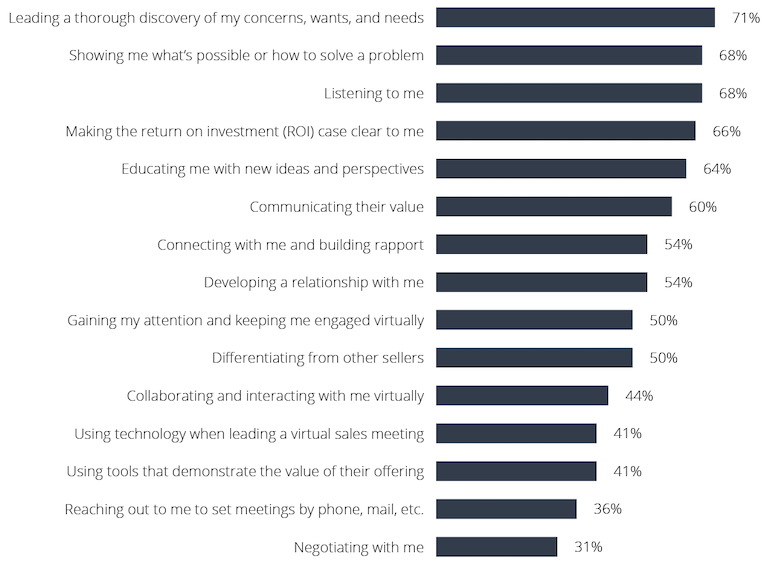How do buyers make purchase decisions? Why do they choose one provider over another? Are there things you, as a seller, can do to influence their decisions?
As the world transitioned to virtual selling in 2020, we wanted to know how this was impacting buyers and sellers alike. We surveyed 528 buyers and sellers across the Americas, EMEA, and APAC. We asked buyers what influences their decisions the most when buying virtually. Their responses provide some interesting insights as to how buyers make decisions.
Below, we’ve compiled the top 9 factors that influence buyers’ decisions and share how you can be more influential in your selling efforts.
How to Influence Buyer Decisions
|
9 Ways to Influence Buyer Purchase Decisions
1. Uncover the Full Set of Buyer Needs
Seventy-one percent of buyers report that leading a thorough discovery of their concerns, wants, and needs is highly influential in their purchase decisions. This confirms our previous research where we found sales winners demonstrate they understand buyer needs 2.5X more often than second-place finishers. And when you look at #3 below, you’ll understand why.
What can you do to conduct a thorough needs discovery?
- Ask both affliction (pain, problems) and aspirational (hopes, goals, future-seeking) questions.
- Ask why. Sellers who uncover the root cause of buyer needs develop the most compelling, robust, and lasting solutions. “Why” is one of the most powerful questions you can ask.
- Prepare questions in advance of your meetings. Do your research and know what information you need to gather.
- Use a checklist. For most sellers there’s a common set of needs you solve. Your checklist can be a prompt to help you thoroughly explore and uncover buyer needs.
For more ideas on how to uncover needs, download our popular guide, 50 Powerful Sales Questions.
2. Show Buyers What’s Possible
Sixty-eight percent of buyers report being highly influenced by sellers who show them what’s possible or how to solve a problem. Interestingly, this also ranked as the #2 top challenge for sellers, with a whopping 89% saying this is challenging for them.
Buyers want it and sellers have a hard time doing it.
One of the best ways to show buyers what’s possible is to walk them through a convincing story and show them how they can get from their current state, which isn't good enough and needs to change, to their New Reality, their desired future state.
3. Listen
Buyers are highly influenced by sellers who listen to them. It’s surprising this is a top factor given that the sales industry has been talking about the importance of listening since Death of a Salesman in 1949 (over 70 years ago!). And yet, buyers today report that only one quarter of sellers are effective listeners. That’s only one in four sellers who listen well—according to your buyers.
The best way to show the buyer you’re listening is to:
- Restate what the buyer has said. Summarize what you’ve heard and confirm you have it right.
- Make eye contact, nod, and give verbal cues that you are actively listening.
- Send a summary email after your meetings to confirm you heard them correctly and inquire if there’s anything else you missed.
- Stop talking so much. This one sounds simple, but it’s a challenge for many sellers.
4. Make a Strong ROI Case
Two-thirds of buyers are highly influenced by sellers who make the return on investment (ROI) case clear. It’s highly influential, yet very few sellers do this well. In fact, buyers say only 16% of sellers are effective at making a clear ROI case.
With this factor in particular there seems to be a large discrepancy between what sellers and buyers think. Of 18 challenges we studied, sellers report making an ROI case as one of the least challenging (15th out of 18 challenges), but buyers think sellers are terrible at it.
What can you do to communicate a strong ROI case? Here’s a good start:
- Calculate the business impact of your solution. Quantify as much as possible using the buyer’s numbers.
- Communicate the emotional impact. Buyers buy with their heart and justify with their heads—you must attend to both to make a strong case.
- Demonstrate the impact compared to the alternative, which could be doing nothing or choosing a competitor.
- Ask what won’t happen to create urgency and demonstrate the negative impact of not moving forward.
5. Educate Buyers with New Ideas and Perspectives
Sixty-four percent of buyers are highly influenced by sellers who educate them with new ideas and perspectives. This is not only influential, but our past research found that educating buyers is the number one factor most separating sales winners from second-place finishers. Winners don’t just do this a little bit more than second-place finishers—they do it almost 3X as often.
6. Communicate Value to Buyers
At the end of any sales process, buyers need to be able to answer 4 questions to build a strong value proposition:
- Why act? Why is this important?
- Why now? What’s the urgency for moving forward?
- Why us? Why are you the best choice among all other options?
- Why trust? Why should the buyer believe you will deliver what you say you can?
Your ability to communicate value is highly influential for 60% of buyers.
7. Build Rapport and Develop Relationships with Buyers
Relationships matter in sales, but the majority of sellers (88%) report that developing relationships virtually is challenging. At the same time, 54% of buyers report they’re influenced by the connection and relationship they have with sellers.
At the end of the day, all things being equal, buyers choose sellers they like. Follow these tips to build rapport with your customers.
8. Work to Gain and Keep Buyer Attention
Fifty percent of buyers report that gaining their attention and keeping them engaged virtually is highly influential in their purchase decision. When selling virtually, attention and engagement are harder to capture and even more difficult to keep.
You can start by building structural engagement into your meetings. For example, you can use virtual white boarding tools, screen sharing, polls, chat, video, visuals, etc. to keep buyers engaged. Engagement is so important in virtual meetings that it’s one of the 4 Virtual Selling ImperativesSM. Download the Virtual Selling Toolkit to learn more about these imperatives and 11 ways to keep buyers engaged.
9. Differentiate Yourself from Other Sellers
Fifty percent of buyers say a seller’s ability to differentiate from the competition is influential and only 21% of sellers are effective at differentiation. Behind making an ROI case, this is another area where buyers rated sellers’ skills the lowest.
Differentiation has two major components:
- Overall distinction: Ask a buyer why they chose one provider over another after they make their purchase and there’s usually more than one reason. There’s a collection of distinctions that ultimately make the winner stand out in the buyer’s mind.
- Perception of scarcity: When a buyer perceives something is scarce, it stands out to them and they tend to desire it more.
Scarce, by the way, doesn’t necessarily mean unique. “Uncommon” can be just as strong and is usually more believable. It’s typically more important to buyers to have expectations met in commonly discussed areas than it is to get something truly novel. For example, many sellers promise quality, results, responsiveness, continuous improvement, ROI, and so on, but few deliver on those promises. Sellers who prove they can deliver well in these areas stand out.
Read: 6 Tips for Differentiating in the Selling Process
The above factors have a high influence on more than half of your buyers. Yes, more than half! But it doesn’t stop there. Each of the fifteen factors we studied highly influenced more than one-quarter of buyers. Here’s the full list:
High Influence on Buyer Purchase Decision

If you want to succeed in sales today, attend to the factors that most influence your buyers’ purchase decisions. Use this knowledge and adjust your selling process to give buyers what they want.







